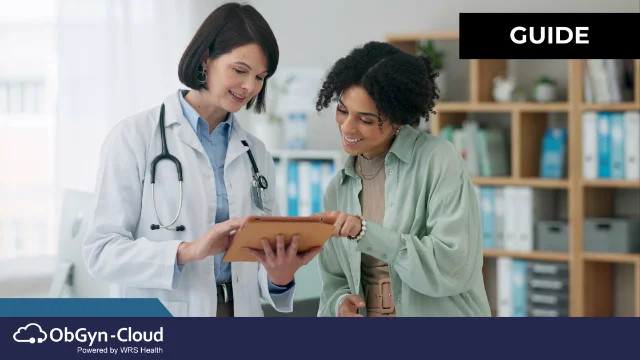Key Takeaways
- OB/GYN-focused tools make documentation faster and more accurate.
- Smart prompts and built-in code logic help you apply CPT codes for OB/GYN procedures properly.
- Accurate linkage of diagnoses—such as for procedures like hysteroscopy or cesarean delivery—can make or break your reimbursement.
- Check out how ObGyn-Cloud supports practices with our quick overview.
As an OB/GYN provider, you’ve already got a lot to manage—juggling patient care, shifting regulations, and maintaining practice efficiency. The last thing you need is for documentation to become a bottleneck in your billing process.
Accurate documentation is essential for successful reimbursement and compliance in OB/GYN care. Every IUD placement, pelvic ultrasound, or cesarean delivery requires precise documentation and a host of linked codes. Miss a field, and your claim could get denied.
More OB/GYN practices are turning to technology to support documentation and coding. The right tools can cut down on errors and keep your revenue cycle moving smoothly. Here’s how.
Table of Contents
Smarter Templates for Faster, Cleaner Notes
Look for systems that let you:
Pre-load templates for common procedures like colposcopy, hysteroscopy, or cesarean section.
Include prompts to ensure you capture documentation tied to CPT codes for OB/GYN procedures.
Add reminders for critical elements, like gestational age or anesthesia time.
For example, when using the hysteroscopy CPT code, a smart template will prompt you to include the right diagnosis details to support medical necessity. These prompts help your team document correctly the first time.
Built-In Code Logic to Avoid Mismatches
Submitting claims without the proper ICD-10 pairing is a fast track to denials. Robust EHR systems do more than store codes—they validate them.
Here’s how OB/GYN-specific technology helps:
Recommends diagnosis codes based on your documentation.
Flags missing or incomplete code pairings.
Alerts your team when modifiers or additional documentation are needed.
Say you’re billing for a colposcopy with biopsy. The system should prompt you to link it to the right cervical dysplasia diagnosis, cutting down on guesswork and re-submissions.
Simplified Modifiers for Obstetrics and Gynecology
Knowing when and how to use modifiers can be tough, especially when multiple procedures are done on the same day. Built-in logic for modifiers can make sure you get it right.
Systems with this feature can:
Suggest modifier 25 for same-day E/M services.
Flag the need for modifier 51 when multiple OB/GYN procedures are done together.
Reduce overuse of modifier 59 by checking for bundled codes.
This support is essential when dealing with CPT codes for OB/GYN procedures that have specific bundling rules or overlap with other services.
Want to avoid common coding errors? Check out our step-by-step guide to clean claims.
Real-Time Updates for the Latest Codes
Each year brings updates to OB/GYN CPT and ICD code sets. Missing or outdated codes can stall your revenue flow.
ObGyn-Cloud and similar platforms handle this by:
Automatically updating code libraries to include the latest revisions.
Removing expired codes and suggesting replacements.
Alerting providers about new documentation requirements for updated codes.
Reduced Administrative Burden
Every minute spent fixing documentation errors or reworking claims is time your staff could spend on patient care. The right technology helps OB/GYN practices reduce that load.
What that looks like:
Less time double-checking chart notes.
Fewer billing questions kicked back to your admin team.
Fewer delays in payments tied to missing details.
For OB/GYN practices already stretched thin, this can make a significant difference in both workflow and revenue.
The Role of an OB/GYN-Specific Patient Portal
Effective documentation starts with accurate patient input. A robust patient portal can gather key details before your patients ever enter the exam room.
OB/GYN-specific platforms often include patient portals that:
Collect pre-visit health histories, including obstetric or gynecological concerns.
Prompt patients to describe symptoms in their own words, aiding diagnosis coding.
Allow patients to upload documents or images that support billing (like prenatal records).
Pre-screen for high-risk procedures—such as those linked to more complex OB/GYN procedure codes.
When patients share these details up front, providers can focus on care—while documentation becomes more complete and claims more accurate.
A Better Approach to CPT Codes for OB/GYN Procedures
Take hysteroscopy as an example. It’s often linked to diagnostic or therapeutic services, so it’s crucial to document the right details.
Technology helps by:
Prompting you to note prior treatments, symptoms, and other clinical justifications.
Making sure the ICD-10 codes (like abnormal uterine bleeding) support medical necessity.
Including images, pathology reports, or patient complaints as supporting documentation when needed.
This level of coding support can mean the difference between a rejected claim and a payment that covers your work.
Strengthen Documentation With Patient Engagement Tools
Beyond basic charting, patient engagement tools can support comprehensive documentation and improved coding accuracy. When patients can participate in their own care process—like through secure messaging or guided forms—they often provide more complete details.
For instance:
Secure messaging lets patients ask questions or provide updates on their symptoms, ensuring providers have the most current information.
Digital intake forms prompt patients to add details about their menstrual cycle, contraceptive history, or pregnancy status, directly feeding into your documentation.
Follow-up reminders and patient education materials reduce the chances of missed documentation or unnecessary re-visits.
These small but meaningful interactions add context to OB/GYN procedure codes and help your team close the loop on everything from annual well-woman exams to postpartum visits.
Unlock Better Insights With Analytics and Dashboards
Technology makes documentation easier. It also creates opportunities to track and improve your practice’s performance. With integrated analytics dashboards, you can quickly see trends in coding and billing outcomes for OB/GYN procedures.
For example, you might find that:
Certain CPT codes for OB/GYN procedures are consistently underpaid due to missing details.
There are seasonal trends in certain services—like an uptick in prenatal care coding during early summer or postpartum care in the fall.
Specific payers often deny claims tied to certain OB/GYN codes, giving you data to address those issues proactively.
Access to this kind of data helps your team identify gaps, adapt documentation processes, and boost revenue. Plus, it keeps you ahead of the curve in an evolving healthcare landscape.
Let Technology Do the Heavy Lifting
Capturing OB/GYN procedure codes accurately is essential to your practice’s financial health. Incomplete fields, mismatched diagnoses, or missing modifiers can slow payments or lead to costly denials. But with OB/GYN-specific technology, you can simplify that work.
By using tools built around OB/GYN workflows, your team spends less time worrying about coding—and more time focusing on patient care. Whether it’s a routine Pap smear or a complex cesarean delivery, the right technology helps you document faster and get paid properly.











